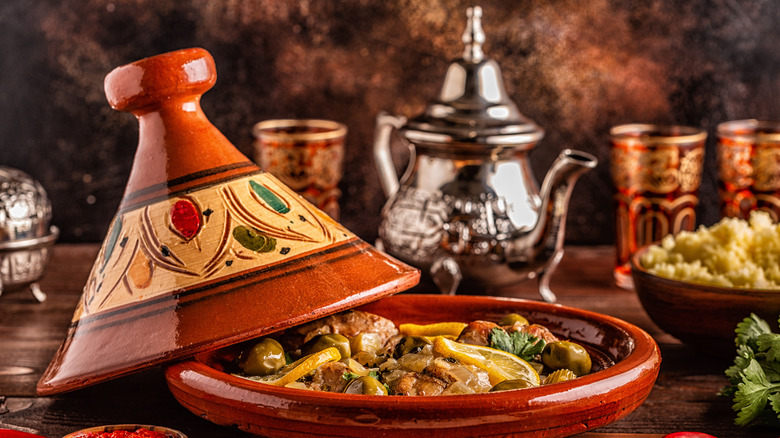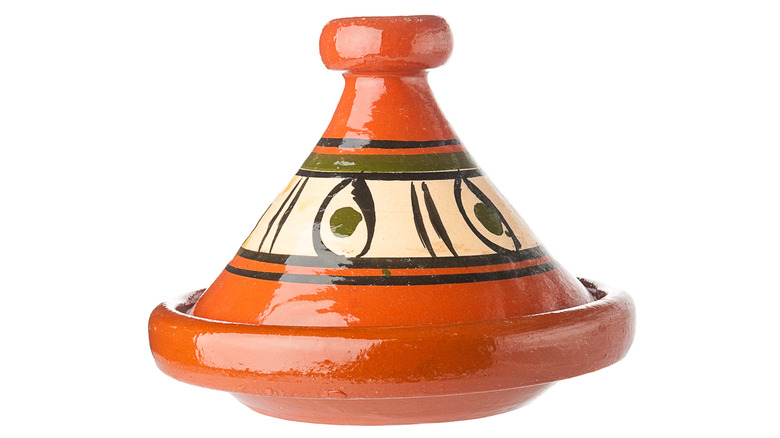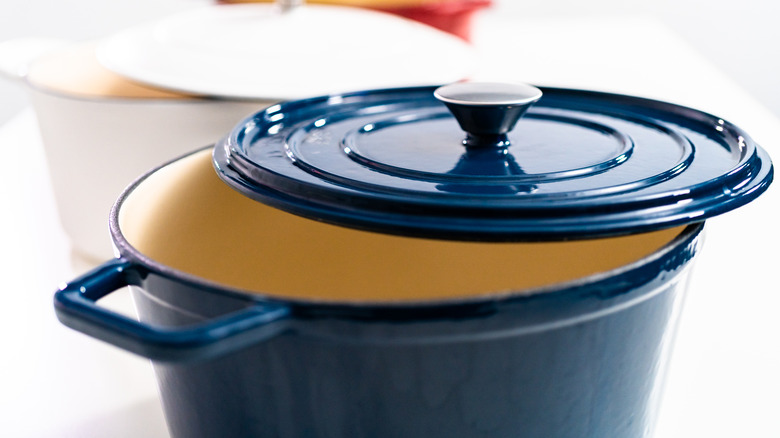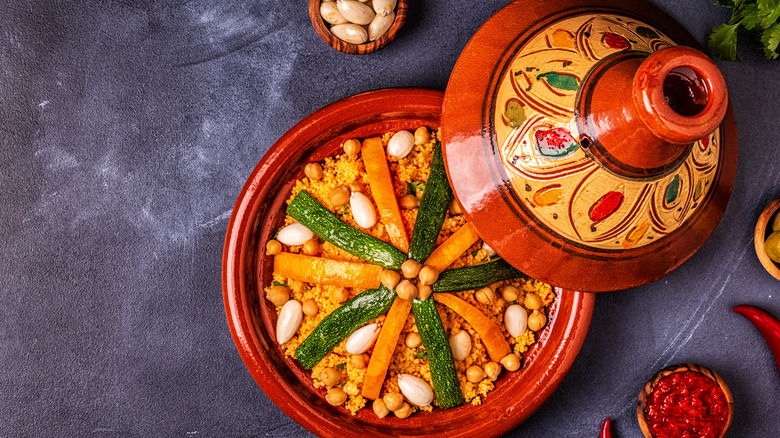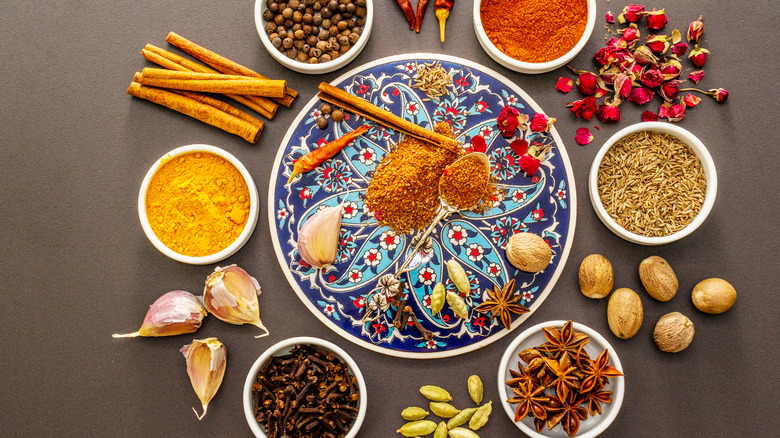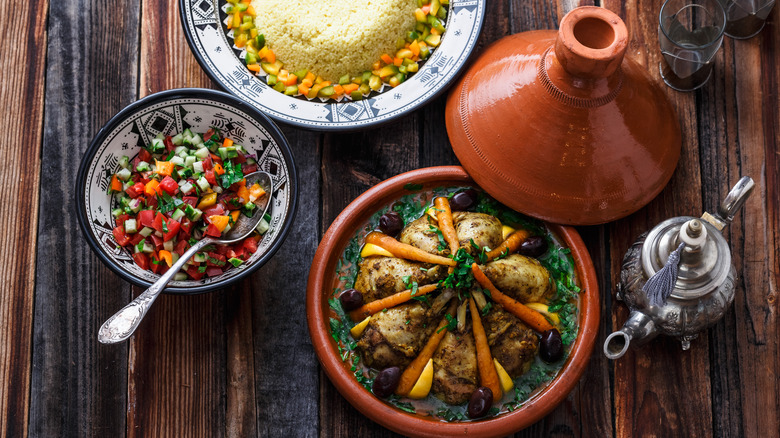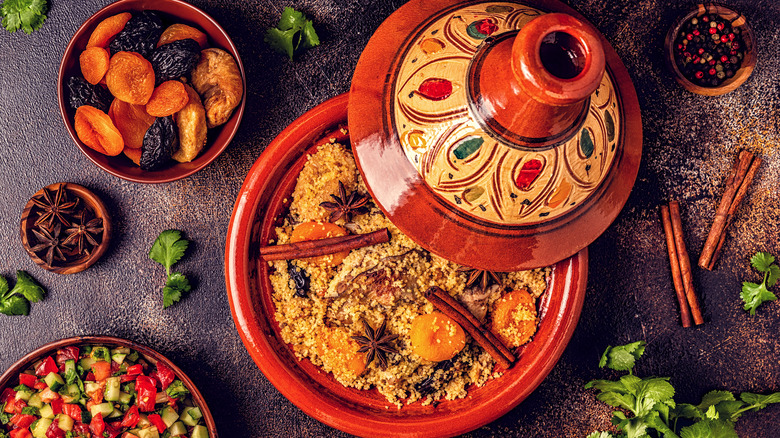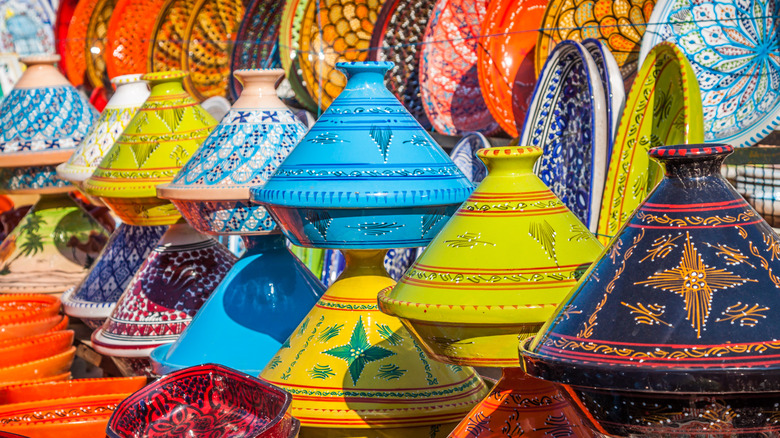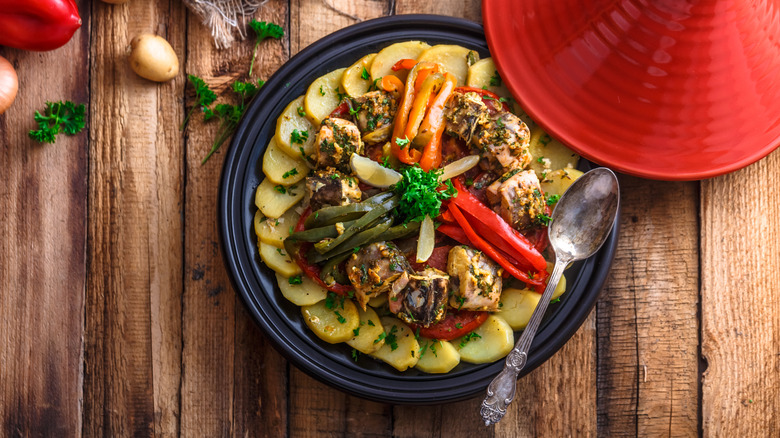What Is A Tagine And How Do You Use It?
Long-simmering stews have long been staples in the cuisines of many cultures, often cooked over low heat for hours and brimming with nourishing ingredients. The contents, flavors, and cookware vary from region to region, making each dish unique and special to that part of the world. A popular one hailing from Morocco is called tagine, also spelled tajine, and it's both the name of the cookware vessel as well as the dish that's prepared within it.
If you're looking for a sweet and savory combination of meat, vegetables, aromatics, and spices, tagine definitely checks all the boxes. It is also incredibly versatile. While it often has red meat – the preparation of which is commonly made using tough cuts that would otherwise be discarded for more desirable parts — it can also include chicken, fish, vegetables, legumes like chickpeas, and eggs. Thanks to the slow-cooking process, just about anything works as it will be tenderized while it cooks, making tagine an appealing meal that is customizable regardless of dietary restrictions.
What is a tagine pot?
Like the dish, tagine is also the name of the cooking vessel it's made with — a shallow clay dish with a cone-shaped lid that seals tightly shut. The shape is particularly important because it allows the food to remain constantly moist as it cooks without having to add more liquid. Reports vary, but Spy indicates that it's believed the Romans introduced ceramics to the North African region in the 18th century.
Modern tagines are made from a variety of materials, however classic versions still use clay. Some may be glazed for heat resistance, and others are more decorative, which is more useful for serving than it is for cooking. The traditional style pot is generally not glazed and can be used from start to finish of a meal. If you plan to buy a tagine dish, a good point to consider is if it will just be for show or also used to cook.
If you buy a new earthenware tagine, Master Class explains that it must be seasoned before cooking with it, to avoid flavors of clay while simultaneously protecting and sealing the dish. The source describes that seasoning can be done by soaking the new dish in water for a couple of hours, drying it, brushing it with olive oil, and baking it for a few hours at 300 degrees Fahrenheit (not unlike seasoning a cast iron skillet). Prior to use, the dish can be brushed with olive oil again to keep it pristine.
Are there substitutes for a tagine vessel?
If you're wondering whether you need to actually buy a tagine pot to cook tagine, the answer is not necessarily. While the dish's name comes from its time spent cooking in this specialty cookware, alternatives can definitely be used. The concept of making this dish really just entails cooking food at low heat for multiple hours in a small amount of liquid, allowing the juices to continually cycle throughout. This is not unlike what occurs when you use a Dutch oven, slow cooker, or a casserole.
My Moroccan Food remarks that the most noticeable difference between using a tagine or a Dutch oven comes down to the earthy taste resulting from the clay. Glazed tagines however will not have this element, also known as "goût de terroir," or "taste of the earth." Therefore, the source advises buying an unglazed tagine if you want to set it apart from your Dutch oven or slow cooker.
The best ways to cook with a tagine
In general, a tagine pot can be heated on the stovetop, in the oven, or traditionally over coals. In all cases, you should avoid exposing it to a direct flame, to avoid cracking the clay. A diffuser can also be placed over the burner if you are using a gas stovetop, in order to eliminate the chance for direct contact.
As the dish sits over the low heat source for a couple of hours, steam will build up within the pot, rising to the top of the cone lid before condensing back down, explains The Telegraph. The source remarks that this method makes the tagine especially important in its place of origin, as the dry deserts of northern Africa don't offer much moisture. A minimal amount of liquid is required since it constantly recycles its way through the dish, resulting in juicy, tender meat. This also means that, with time, the ingredients slowly begin to caramelize and create even richer flavors.
The dish known as tagine is equally as unique
The history of tagine is wide and varied – Arab America notes that similar recipes were included as far back as the 9th century publication "The Thousand and One Nights." The source further explains that the dish became popular later in the 18th century under the rule of Harun al Rashid. Travel Food Atlas remarks that tagine also displays a mix of influences from Berber, Arabian, and European cultures.
The actual contents of a tagine are variable, though they traditionally star lamb or chicken. Some classic styles, according to Chatelaine, include chicken with preserved lemons and olives, chicken with almonds and apricots, as well as lamb or beef with prunes. In addition, meatballs, fish, vegetables, beans, and shakshuka (a dish of eggs and tomatoes) can all be prepared in a tagine. In general terms, the dish tangine contains a choice of protein, vegetables, fresh herbs, spices, dried fruits, and nuts. There is nothing unidimensional about tagine, either — sweet and savory flavors often mingle with rich, earthy aromas in this appetizing stew.
These spices are commonly used in tagine
Besides the importance of the cooking vessel, the spices used in tagine are essential to the overall characteristics of the dish. In a historical reference, NYT Cooking explains that over time, spices from the Middle East combined with surrounding regions as the Islamic Empire spread west, and this confluence of styles eventually made its way to Northern Africa. (More specifically, the Maghreb region which includes Morocco, Algeria, Libya, Mauritania, and Tunisia.) Although the source notes that modern-day spice blends are often simplified, the lasting influence of such varied seasonings is evident.
The specific spices that are used in tagine vary regionally, and even differ among households, not unlike India's garam masala. Some of the common spices used in tagine can include cumin, paprika, clove, cinnamon, coriander, cardamom, nutmeg, peppercorn, ginger, and turmeric. One of the iconic spice blends fundamental to Moroccan cuisine is ras el hanout, which can contain dozens of ingredients, including the characteristic fragrant aromas of saffron (via NYT Cooking).
How do you make tagine?
Once your tagine cookware is seasoned and ready to use, it's time to assemble the dish. Unlike some stews where you throw everything into the pot at once, tagine is all about layering the ingredients. Also in contrast to other long-simmering preparations, Chatelaine explains that the meat is not usually browned in a pan prior to adding it to the dish.
Master Class further describes the procedure for layering the various components: First, spread the sliced vegetables on the bottom of the pot to create a bed for the subsequent ingredients. You don't have to get fancy — onions, carrots, and celery are sufficient. Next, pour in a healthy dose of olive oil to add complexity to your sauce. The protein goes in after that by placing it in the middle and filling in the surrounding area with vegetables. Then, season everything inside with your blend of spices — for simplicity, pre-mixed ras el hanout does the trick. Extras such as fresh herbs, preserved lemon, dried fruits, nuts, or olives should then go on the top. Finally, add some stock or water to the dish, so that it doesn't dry out during the long cooking time. Cook over low heat for three to four hours, checking midway to see if there is still sufficient liquid. If not, pour in a bit more water or stock.
When the meat is tender, you're ready to dig in. No need to get another dish dirty — a tagine vessel is the perfect serving tool.
What does tagine taste like?
Since tagine can be made using all types of meats, legumes, vegetables, spices, and extras, the flavor profile can vary significantly each time you cook it. For a heartier meal with robust flavors, try making a lamb or beef tagine. If you're looking for something lighter, fish or chickpeas are a great choice.
Generally, the idea is to combine savory, earthy, sweet, and sour components for the ultimate balance of flavors. This is where spices, dried fruits, nuts, aromatic essences such as orange blossom water, and fresh herbs really come together to build the complex taste. Tagine is not necessarily spicy, but the addition of harissa, a chili paste, will certainly raise the heat if desired. While other stew-like dishes use aromatics such as bay leaves and alliums to build flavor, tagine is unique in that it uses plenty of warm spices.
Due to the long cooking process, the different ingredients have plenty of time to absorb and reabsorb the seasonings as well as their own juices, resulting in deep caramelized flavors. Consequently, the meat is also incredibly tender, adding to the rich nature of the dish.
Since tagine incorporates various elements and is essentially a one-pot dish, a simple starch such as rice, couscous, or flatbread is all you need to serve alongside it and is great to have to sop up the delicious sauce.
Where to buy tagine
If you plan to prepare your own tagine, you will need the right cookware, whether it's a tagine pot, a Dutch oven, or a slow cooker. Tagines are increasingly easy to find in mainstream stores, though for the ultimate authentic version you may want to import one from Morocco or find a specialty store that has done so.
Otherwise, brands like Le Creuset and Williams Sonoma make their own version, and tagines can even be found at Walmart or on Amazon. You'll find an assortment of materials each is made from, usually including clay, terracotta, stainless steel, or cast iron. Make sure to buy one that can withstand heat if you plan to use it for both cooking and serving. (The beautiful painted pots won't look so great once they crack into pieces.) Decide on a size, which can range from small to large and serves about two to eight people.
As for the ingredients to prepare tagine, the dish is sufficiently adaptable and you should be able to find everything needed in a standard supermarket. If you want to add various extras, you might need to check the international aisle or a specialty food store to find items such as orange blossom water, harissa, and preserved lemons. Ras el hanout can be bought pre-packaged and may be available in some regular supermarket spice aisles. Otherwise, the individual spices should be easy to find and you can always make your own blend at home.
Nutritional information about tagine
As far as the nutritional aspects of this delicious dish are concerned, they will vary widely depending on the contents you choose to include. Whether you opt for a fatty piece of lamb and fill the remaining space with dried fruits and nuts, or go for a spice-heavy dish with chickpeas and vegetables, the nutrition content will differ significantly. Consequently, you can adapt the dish, sticking to leaner meats and vegetables for a lighter version, or use more rich ingredients for a heartier meal.
Notably, the way in which tagine is cooked means that it preserves valuable nutrients. Besides amplifying the flavors by allowing them to thoroughly infuse throughout the dish, Wild Nutrition explains that, in slow cooking, the nutrients remain absorbed since everything is sealed up. Additionally, you don't have to resort to frying meat in order to develop heavenly caramelized aromas in this dish, which ultimately makes it healthier. More flavor with less fat and calories is definitely something to get behind.
Ras el hanout and the assortment of spices used all carry an array of purported health benefits as well. The exact characteristics will of course vary depending on which spices you incorporate, but many assist in digestion, reduce inflammation, and have stimulatory properties, according to Moroccan Food. Many spices also contain valuable essential oils. With tagine, there's proof that healthy eating can be delicious, too.
